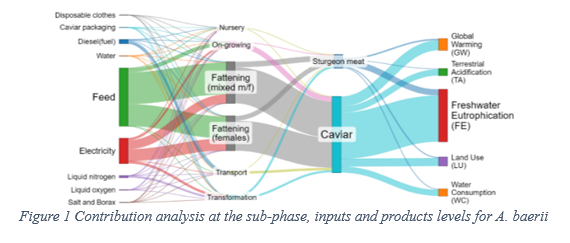ENVIRONMENTAL PERFORMANCE OF FARMED STURGEON CAVIAR PRODUCTION: AN LCA STUDY ON LUXURY FOOD
Introduction
Aquaculture is generally regarded as one of the most sustainable sources of animal-derived food (Gephart et al., 2021). Nevertheless, the variety of farmed species, technologies, and practices across regions requires product-tailored evaluations, especially for poorly studied luxury foods, such as caviar. Traditionally derived from wild female sturgeons, caviar is now primarily obtained through aquaculture due to the depletion of wild stocks (Bronzi et al., 2019). With 65 tons produced in 2023 (EUROSTAT, 2023), Italy ranks third in global caviar production, following China and Russia (EUMOFA, 2021). This study aims at (1) assessing for the first time the environmental performances of caviar production, including its co-products (i.e., meat), from different sturgeon species reared in a representative Italian farm, using the Life Cycle Assessment (LCA) methodology, and (2) evaluating, through scenario analysis, the effects of potential impact mitigation strategies.
Materials and methods
The enterprise in northern Italy produces caviar from four sturgeon species: H. huso, A. baerii, A. transmontanus, and A. gueldenstaedtii. The production chain includes sturgeon farming and caviar/meat processing. Farming involves four sub-phases: nursery, on-growing, mixed males and females fattening, and females fattening. Sturgeons are raised in indoor recirculating aquaculture systems (RAS) and outdoor raceways. The water that feeds all the systems comes from a nearby freshwater channel. A sedimentation and biological filtration system is in place. The facility meets its energy needs using electricity from the grid and an in-house photovoltaic system (PV). As soon as males are identified (at 3-8 years, depending on the species), they are processed for meat, while females are raised until sexual maturity (8-20 years, depending on the species) for egg collection and meat processing. Eggs are processed, salted, and packed in tins or jars for sale.
The analysis used the Life Cycle Assessment (LCA) methodology (ISO 14040 and 14044), with a cradle-to-gate approach. The functional unit (FU) was defined as 1 kg of caviar (reference flow: 1 kg of caviar and 5.9 kg of marketable meat), with economic allocation applied. Primary data were gathered via questionnaires and site visits (reference production year: 2022–2023), while background data were sourced from Ecoinvent 3 and Agri-footprint 6.3. Calculations were performed using SimaPro 9.5, adopting ReCiPe 2016 Midpoint (H), Cumulative Energy Demand and CML-IA baseline methods. LCA’s output allowed the identification of critical hotspots along the caviar production chain, which were also used to forecast two impact mitigation scenarios: 1) optimization of feed use by hypothesizing the application of a genetic early sex determination strategy (Kuhl et al., 2021), and 2) energy transition, i.e., by increasing the in-house PV power supply up to 50% of the energy needs.
Results
LCA results showed high variability depending on the species, e.g., Global Warming (GW) ranged between 53 and 83 kg CO2 eq/kg of caviar, Terrestrial Acidification (TA) between 0.18 and 0.29 kg SO2 eq/kg of caviar, Freshwater Eutrophication (FE) from 0.02 to 0.05 kg N eq./kg of caviar, Land Use (LU) from 43 to 93 m2/kg caviar, and Cumulative Energy Demand (CED) from 714 to 1153 MJ/kg of caviar. For all the species, the fattening phases had the highest impact contribution, ranging from 80% in GW for A. gueldenstaedtii to 94% in FE and 99% in LU for H. huso. In all cases, the inputs that collectively accounted for >95% of the impacts were feed, electricity and transportation. Figure 1 depicts the contribution analysis at the sub-phase, inputs and products levels for A. baerii. The scenario analysis showed that: i) an early genetic sex determination allows a significant reduction in the feed used with consequent decrease in impacts (e.g., up to -21% of the impacts related to Freshwater Eutrophication-FE); ii) increasing the supply of renewable energy at the farm level is effective, but to a different extent depending on the species considered (from -2% to -19 % for GW).
Discussion and Conclusions
Caviar production comes with significant environmental impacts, although mitigation strategies could improve its sustainability. Species-specific differences are mainly driven by farming cycle duration, feed requirements, and production efficiency. The fattening phase emerged as the primary contributor to impacts due to its length and resource intensity, with feed identified as a key hotspot, as also reported by Bohnes et al., 2019 and Gephart et al., 2021. Electricity was the second major hotspot: substituting grid electricity with solar energy reduced GHG emissions but increased abiotic resource depletion. Despite this burden shift, renewable energy remains essential for decarbonising the sector (De Vet et al., 2024). This study also underscores the methodological challenges in assessing complex systems through LCA, such as, for example, the choice of the appropriate FU, system boundaries, and temporal coverage for data collection.
References
Bohnes et al. (2019). Life cycle assessments of aquaculture systems: a critical review of reported findings with recommendations for policy and system development. In Reviews in Aquaculture 11 (4), 1061–1079.
Bronzi et al. (2019). Sturgeon meat and caviar production: Global update 2017. Journal of Applied Ichthyology, 35(1), 257–266.
De Vet et al. (2024). Techno-economic analysis for the energy transition of the EU fisheries and aquaculture sector. https://doi.org/10.2926/462100
EUMOFA. (2021). The caviar market: production, trade and consumption in and outside the EU: an update of the 2018-report. Publications Office of the European Union.
EUROSTAT. (2023). Production of fish eggs for human consumption from aquaculture (from 2008 onwards). (accessed on 16/04/2025).
Gephart et al. (2021). Environmental performance of blue foods. Nature, 597(7876), 360–365.
Kuhl et al. (2021). A 180 Myr-old female-specific genome region in sturgeon reveals the oldest known vertebrate sex determining system with undifferentiated sex chromosomes. Philosophical Transactions of the Royal Society B: Biological Sciences, 376(1832).
